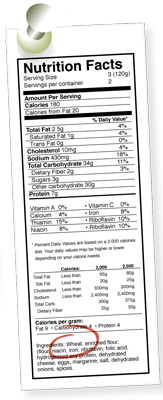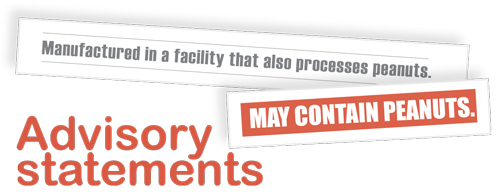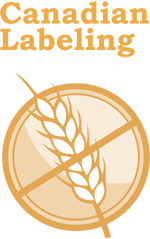
 |
 |
 |
 |
 |
 |
 |
 |
As you will learn, carefully reading and interpreting food labels is a critical skill that people with special dietary needs must develop to ensure they make safe and healthy food choices. Here's some information to help you get started...
 FALCPA
FALCPA
The Food Allergen Labeling and
Consumer Protection Act (FALCPA)
helps protect Americans with food
allergies and special dietary needs.
Improved and clearer food labeling
enables individuals to easily identify
safe foods. The law applies to all foods
regulated by the U.S. FDA that were
labeled on or after January 1, 2006.
FALCPA requires that manufacturers
clearly disclose whether products
contain any of the eight major
allergens: dairy, eggs, fish, shellfish,
tree nuts, peanuts, wheat and soy.
Ingredient lists must declare the allergen
in plain language. Food manufacturers
must label food products that contain
an ingredient that is or contains protein
from a major food allergen in one of two
ways: include the name in parenthesis or
place the word “contains” followed by
the name of the food source from which
the allergen is derived. Allergenic
ingredients must be listed even if they
are present in trace amounts (i.e. in
colors, flavors or spice blends) and the
specific type of tree nut (i.e. almond,
cashew, walnut), fish (i.e. cod, flounder,
sole) and shellfish (i.e. crab, lobster,
shrimp) must be declared. Visit
www.fda.gov to learn more.
![]()
 While over 160 foods can cause allergic reactions in sensitive
individuals, there are eight common foods which account for 90%
of all food allergic reactions in the U.S.— dairy, eggs, fish,
shellfish, tree nuts, peanuts, wheat and soy. Note that
while FALCPA requires that wheat be declared on food labels, other
sources of gluten (i.e. barley and rye) are not required to be disclosed.
While over 160 foods can cause allergic reactions in sensitive
individuals, there are eight common foods which account for 90%
of all food allergic reactions in the U.S.— dairy, eggs, fish,
shellfish, tree nuts, peanuts, wheat and soy. Note that
while FALCPA requires that wheat be declared on food labels, other
sources of gluten (i.e. barley and rye) are not required to be disclosed.
![]()
Gluten is the general name for certain types
of proteins that are found in wheat, barley
and rye and their derivatives. Gluten is
commonly found in breads, pastas and baked
goods, but it may also be present in soy sauce,
licorice, beer, processed meats, cosmetics
and some medications.
The following ingredients are not allowed
in any form on a gluten-free (GF) diet: wheat
(durum, farina, graham, kamut, semolina,
spelt), rye, barley and triticale (a cross
between wheat and rye). Malt flavoring
and malt vinegar may be derived from barley
and should be avoided on a GF diet.
Some acceptable GF grains and flours are:
rice, corn, potato, tapioca, beans, garfava
(chick pea and fava bean blend), sorghum,
quinoa, millet, buckwheat, arrowroot,
amaranth, teff, Montina® and nut flours.
![]()

It is very important to remember that wheat-free does not necessarily
mean that a food is also GF, as it may contain other gluten sources
(such as barley or rye). Conversely, if a food is labeled as GF, it
cannot contain wheat.
![]()
 FALCPA does not require manufacturers to
declare gluten on food ingredient labels, so it
can be very hard to identify gluten-containing
foods. The U.S. FDA is required to issue a rule
that defines and permits the voluntary use of
GF claims on food labels; however, a final rule
has not yet been published. In the meantime,
independent organizations, like the Gluten-
Free Certification Organization (GFCO), have
developed GF certification programs to help
GF consumers better interpret food labels and
find foods they can safely enjoy.
FALCPA does not require manufacturers to
declare gluten on food ingredient labels, so it
can be very hard to identify gluten-containing
foods. The U.S. FDA is required to issue a rule
that defines and permits the voluntary use of
GF claims on food labels; however, a final rule
has not yet been published. In the meantime,
independent organizations, like the Gluten-
Free Certification Organization (GFCO), have
developed GF certification programs to help
GF consumers better interpret food labels and
find foods they can safely enjoy.
Learn more at www.gfco.org
![]()

Many food labels include allergen advisory statements such as
“May contain peanuts” or “Manufactured in a facility that
also processes peanuts.” These advisory statements are not
required under FALCPA and are voluntarily included by food
manufacturers to advise consumers of potential risks.
These advisory warnings can be very confusing to consumers
trying to make smart and safe food choices. The FDA is considering
new rules on the use of advisory statements by manufacturers.
In the meantime, always call the manufacturers’ toll free number to
get your questions and concerns addressed before consuming any
questionable foods.
![]()

A dedicated facility means that a product is produced in a
manufacturing facility that is free from a specific allergen
(typically tree nuts or peanuts) and/or gluten. Dedicated
facilities offer consumers the highest level of assurance that
the foods are safe and free from cross-contamination. If you
have questions, contact the manufacturer directly to determine
where and how the product is made.
![]()
 Health Canada, the department of the
Canadian government responsible for
national public health, is revising labeling
regulations to ensure that the most
common food allergens (peanuts, tree
nuts, shellfish, dairy, eggs, fish, soy,
sesame seed, wheat, mustard and
sulfites) are always identified by their
common names, allowing consumers to
easily recognize them. Allergen labeling
regulations are not yet in effect.
Health Canada, the department of the
Canadian government responsible for
national public health, is revising labeling
regulations to ensure that the most
common food allergens (peanuts, tree
nuts, shellfish, dairy, eggs, fish, soy,
sesame seed, wheat, mustard and
sulfites) are always identified by their
common names, allowing consumers to
easily recognize them. Allergen labeling
regulations are not yet in effect.
Canada does have specific gluten-free
labeling regulations. In Canada, GF foods
are defined as those that do not contain
wheat, including spelt and kamut, or
oats, barley, rye or triticale.
Be sure to read all food labels carefully before buying or consuming a product. Manufacturers change product ingredients from time to time, so just because the product was once safe to eat doesn’t mean it will always be. If you have any questions, call the manufacturer’s toll free number.








